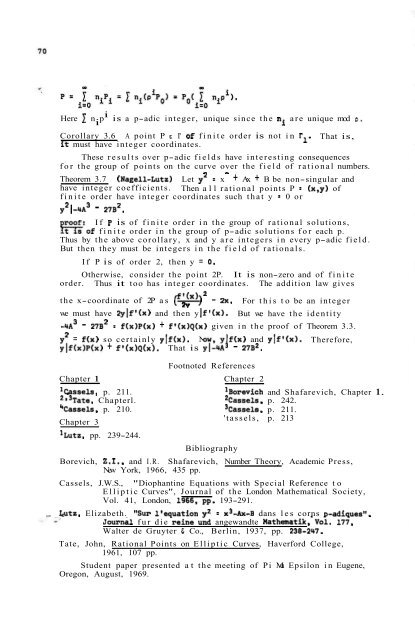You also want an ePaper? Increase the reach of your titles
YUMPU automatically turns print PDFs into web optimized ePapers that Google loves.
Here I n ip i is a p-adic integer, unique since the ni are unique mod p.Corollary 3.6 A point P E I' of finite order is not in I'. That is,It must have integer coordinates.These results over p-adic fields have interesting consequencesfor the group of points on the curve over the field of rational numbers.- -Theorem 3.7 (Nagell-Lutz) Let yz = x + Ax + B be non-singular andhave integer coefficients. Then all rational points P = (x,y) offinite order have integer coordinates such that y = 0 ory21 - 4 - ~ 2~7 ~ ~ .If P is of finite order in the group of rational solutions,%of finite order in the group of p-adic solutions for each p.Thus by the above corollary, x and y are integers in every p-adic field.But then they must be integers in the field of rationals.If P is of order 2, then y = 0.Otherwise, consider the point 2P. It is non-zero and of finiteorder. Thus it too has integer coordinates. The addition law givesf'(x) 2the x-coordinate of 2P as (-1 - 2x. For this to be an integer2vwe must have 2y1f '(XI and then y If '(XI.- 4 - ~ 2~7 ~ ~But we have the identity= f(x)P(x) + fV(x)Q(x) given in the proof of Theorem 3.3.y2 = f(x) so certainly y[f(x). <strong>No</strong>w, y f(x) and y[f'(x).ylf(x)~(x)+ fv(x)Q(x). That is yl-4f14 - 2 7~~.Footnoted ReferencesChapter 1 Chapter 2Therefore,'~assels, p. 211. '~orevich and Shafarevich, Chapter 1.ate, Chapterl.2~assels, p. 242."~assels, p. 210.3~assela, p. 211.Chapter 3'tassels, p. 213'~utz, pp. 239-244.BibliographyBorevich, 2.1.. and I.R. Shafarevich, Number Theory, Academic Press,New York, 1966, 435 pp.Cassels, J.W.S., "Diophantine Equations with Special Reference toElliptic Curves", Journal of the London Mathematical Society,<strong>Vol</strong>. 41, London, 1966.. 193-291.Lutz. Elizabeth. "Sur lvequation y2 = x3-Ax4 dans les corns D-adioues".~ournal fur die -reine uid angewandte ~athematik,~oi. 177,Walter de Gruyter E Co., Berlin, 1937, pp. 238-247.Tate, John, Rational Points on Elliptic Curves, Haverford College,1961, 107 pp.Student paper presented at the meeting of <strong>Pi</strong> <strong>Mu</strong> <strong>Epsilon</strong> in Eugene,Oregon, August, 1969.A DECIMAL APPROXIMATION TO n UTILIZING A POWER SERIESTim Golian and John HannekenOhio UniversityCAN A CIRCLE BE SQUARED? This question has puzzled mankind sinceantiquity. Even before the 17th century mathematicians believed thatthe key to answering this question lie in a very special number - pi,the ratio of the circumference of a circle to its diameter. Sincethat time, mathematicians have tried to find a unique value for pi.Their attemps can be divided into three distinct periods.In the first period, which was from the earliest times to themiddle of the 17th century, the principle aims of mathematicians'studies were directed toward the approximation of pi by calculationsof perimeters or areas of regular inscribed and circumscribed polygons.From the middle of the 17th to the middle of the 18th century,the calculus of infinite series was utilized in the development ofexpressions for pi.The last period, extending more then 150 years, pertained primarilyto investigating and characterizing pi. In 1761. J.H. Lambert provedthe irrationality of pi and in 1882 transcendence was established byF. Lindeman.In the following development of IT the specific objective relatesto the second period, and thus the basic relations introduced in thatera will be examined. Early expressions such as:do not converge rapidly enough for practical use. For example, thelatter expression, according to Newton, would require 5 BILLION termsto accurately calculate the value of pi to 20 decimal places. Theserelations were replaced by relations based upon the power seriesx5 x 7arctan (x) = x - *Â + - - - + . . . (-1 x < 11, which was discovered3 5 7by James Gregory in 1671.There are nine Important relations based on Gregory's series.These are:1 14 2 3#1. = arctan - + arctan -Charles Hutton - 17761 1#2. = = 4 arctan - - arctan - John Machin - 17064 5 239
















